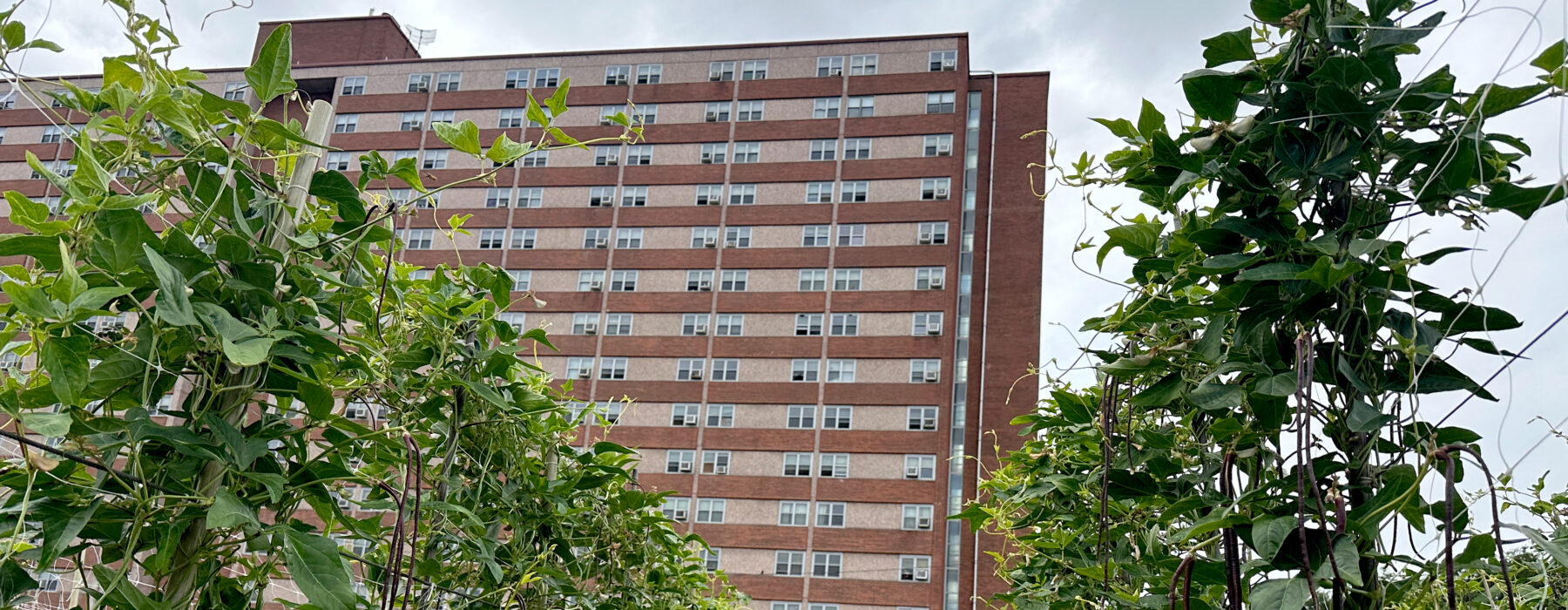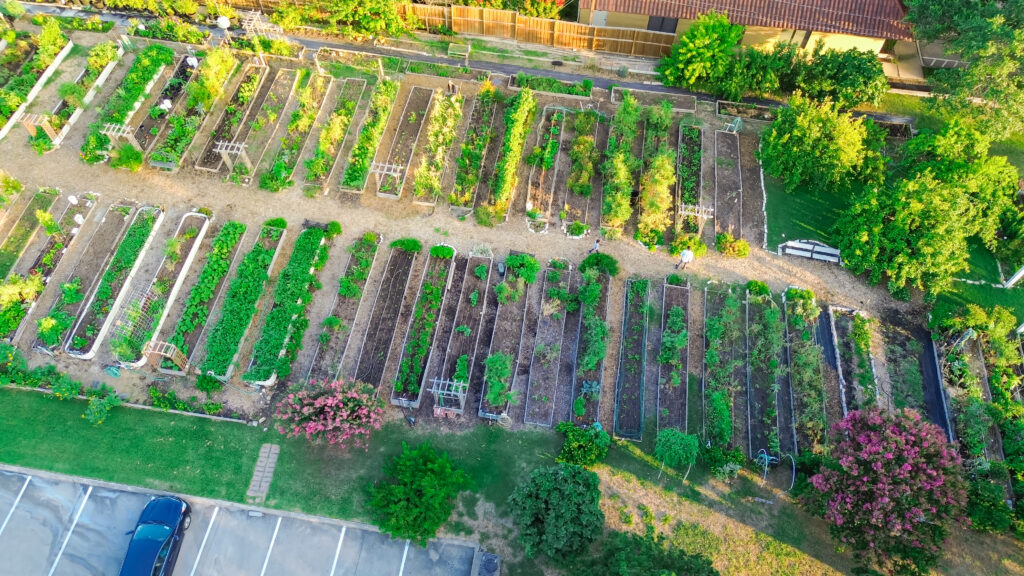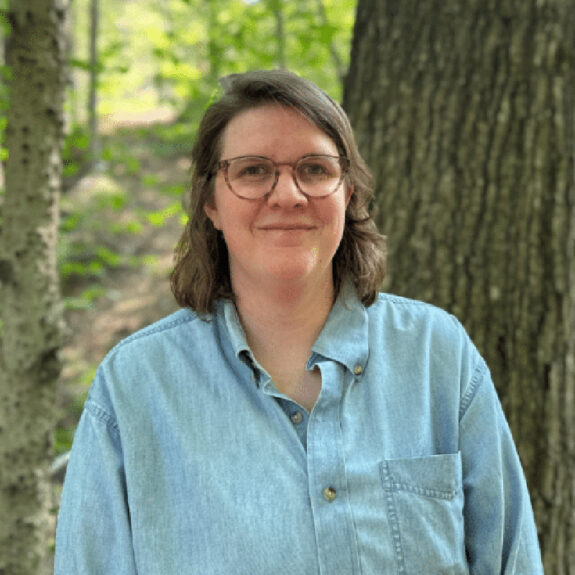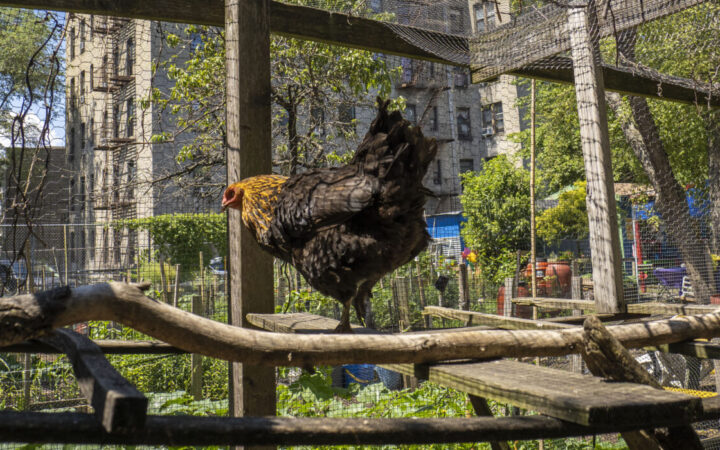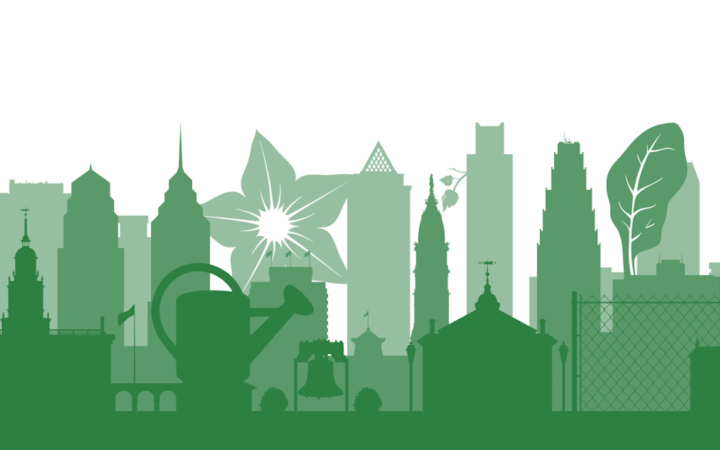This guide highlights how local governments across the U.S. are shaping laws and regulations that impact urban farms, community gardens, and innovative food producers. The guide explores key topics—land access, zoning and land use, city governance, water access, soil health, and innovative production—to assess common challenges farmers and gardeners face and offer concrete strategies, city highlights, and takeaways for both policymakers and producers.
Introduction
What is “urban agriculture”? Definitions vary from city to city and even from individual to individual. Urban agriculture can mean for-profit farming or nonprofit community gardens, or both; it can be limited to agriculture within a city’s limits, or it can expand to include peri-urban and exurban farms that serve urban markets; it can include rooftop farms, indoor farms, container farms, or indoor aquaculture; it can orient itself toward social justice and mutual aid or simply provide a farmer’s livelihood. However urban agriculture is defined and whatever form it takes, individuals or groups who want to produce food in urban settings must navigate the complex landscape of municipal ordinances, zoning restrictions, and other local government-specific regulations inherent to any land-based activity.
Urban agriculture has a rich history in the United States. Well before Europeans reached this continent, Indigenous peoples of the Southwest, including Hohokam and Pueblo civilizations, cultivated crops within their densely populated settlements, irrigated by a sophisticated series of ditches and canals diverting water from nearby rivers. After the founding of the United States, as cities grew and industrialized and most of American food production shifted to rural areas, urban agriculture persisted primarily as a response to economic hardship, national crisis, or as a community survival strategy practiced by immigrant and internal migrant populations. In the 1890s, a nation-wide economic downturn prompted city-dwellers across the U.S. to organize vacant lot cultivation associations to curb widespread food insecurity. Perhaps most famous among these efforts was Detroit mayor Hazen Pingree’s “potato patch plan,” under which 430 acres of Detroit’s vacant lands were tilled up and divided into small vegetable plots tended by as many as 1,500 local families.
Urban agriculture has a foothold in cities across the United States, ranging from small allotment gardens to multi-acre for-profit farms to high-tech indoor hydroponics operations.
Cities around the country emulated Pingree’s success with vacant lot cultivation programs of their own. The federal government and cooperating local governments encouraged small-scale agriculture in cities during both world wars and the Great Depression, labeled variously “war gardens,” “victory gardens,” or “relief gardens,” as important strategies to bolster national food security. Government support for urban agriculture reached its height during World War II, when more than 18.5 million “Victory Gardeners” supplied more than 40 percent of the country’s fresh produce. In the years following the end of the war, that support receded and urban food production declined. However, the practice of urban agriculture persisted through the remainder of the twentieth century in the form of school gardens, home gardens, community gardens, and self-organized “guerrilla” gardens in neighborhoods with high rates of vacant land and limited access to resources like full-service grocery stores.
Since the early 2000s, local, state, and federal governments have taken a renewed interest in supporting and promoting urban agriculture and innovative production. Urban agriculture now has a foothold in cities across the United States, ranging from small allotment gardens to multi-acre for-profit farms to high-tech indoor hydroponics operations. These gardens, farms, and innovative production sites grow fresh food for city residents while providing many other benefits. They cool down areas that experience the urban heat island effect; divert and absorb stormwater runoff and improve air quality; and provide habitat for pollinators and beneficial biodiversity. They also offer green space for community connection, food education, and local economic development. To maximize these benefits, many cities have created urban agriculture offices and implemented urban agriculture ordinances. Some cities, like Detroit, have recognized urban agriculture as one strategy to spur community and economic development in a post-industrial city. Other cities, like New York, have found an enduring public benefit to city-sponsored community gardens. State agriculture departments have developed programs to support their urban farming constituents. The U.S. Congress and President Trump recognized the national-scale importance of urban agriculture by creating the USDA’s Office of Urban Agriculture and Innovative Production in the Agriculture Improvement Act of 2018, commonly referred to as the “farm bill.”
Local Government Law
Local governments retain control over most of the key policy levers that impact the daily operations of urban farmers and innovative producers. Cities derive their power to enact ordinances and regulations through delegations of authority from state governments. While this local authority cannot contradict state or federal laws—for example, a city cannot enact an ordinance that allows a local business to pollute a waterway in violation of the federal Clean Water Act—municipalities have a lot of power to influence the day-to-day lives and activities of their residents. Urban agriculture is one such activity. Local authorities oversee land use regulation, land access pathways, and public utilities like municipal water and power. They serve as vital conduits of local, state, and federal funds to urban food production initiatives. They have broad authority to support or regulate local food production as they see fit. When farmers and gardeners operate an urban farm, they are subject to local zoning codes that may specify how high plants can grow on any given parcel and whether chickens or bees can be kept within city limits, and they are often required to file permit applications to sell produce from their farm site or build accessory structures like hoop houses.
Because of these powers common to local governments, successful urban producers need to know how to navigate local laws, regulations, and processes for accessing necessities like water, power, land, and, in some cases, material support for their work. However, urban producers often find it difficult to access information about those policies or understand their implications for urban farming and gardening, even in cities with a policy environment largely supportive of urban agriculture. On the other side of the coin, municipal policymakers may not be familiar with urban agriculture, understand its benefits to a city, or have a clear idea of what policies are needed to support urban food production.
How to Navigate This Guide
This guide intends to shed light on some of the ways that local policy impacts urban agriculture and innovative production, and to offer examples of strategies that some American cities have used to build policy around their own urban farms and gardens.
After completing a policy scan of the original 17 cities named by the USDA Office of Urban Agriculture and Innovative Production as “urban agriculture hubs,” CAFS has identified several key policy areas that are most likely to impact urban producers:
▶ Land Access
▶ Zoning and Land Use
▶ City Governance and Public Funding
▶ Water Access
▶ Soil Health and Composting
▶ Innovative Production
Each section of the report provides an overview of the specific policy and regulatory barriers faced by urban and innovative producers, offers policy strategies that policymakers can use to help producers overcome those barriers, and highlights examples from cities and states that have laws and policies supporting urban agriculture and innovative production. Each of the sections follows this basic format:
▶ Key terms and important context
▶ Barriers facing urban and innovative producers
▶ Policy strategies to overcome these barriers
▶ Key takeaways for producers and policymakers
While we have tried to make most of the information in this guide pertinent to everyone with an interest in urban agriculture and innovative production, we have made a special attempt to highlight information that may help producers navigate their local policy environment, as well as information that may help municipal policymakers better respond to the needs of producers.
Acknowledgements
This report was produced by the Center for Agriculture and Food Systems (CAFS) at Vermont Law and Graduate School. The coauthors are Liz Turner, Lihlani Nelson, Emily Spiegel, and Margaret Kaniecki, with editorial and production support from Laurie Beyranevand JD‘03, Lindsey Connolly MELP‘11, and Austin Price, and design by Jeff Wainer of Vermont Design Collective.
Student researchers include Abby Avital, Benjamin Behimer JD’27, Emily Collins MFALP‘24, Maya Graeber JD‘24, Margaret Kaniecki, Christina Karem JD‘25, Seth Israel, Grace McGuire JD‘27, Nicole Renna JD/MFALP‘25, Travis Rosenbluth JD‘24, Whitney Roth JD ‘25, and Nicole Sharifi.
A special thank you goes to this project’s advisory group for providing their insight and feedback: Anita Adalja (Ashokra Farm/Not Our Farm), Yemi Amu (Oko Farms), Duron Chavis (Happily Natural), Andrea Clark (independent consultant), Nelson Hawkins (We Grow Farms/Ujamaa Farmer Collective), Christian Kanlian (The Urban Assembly School for Green Careers), Amanda Karls (Foodvocate LLC), Susie Marshall (GROW North Texas), Flynne Olivarez (Mariquita Medicinals), Molly Riordan (The Center for Good Food Purchasing), Ismail Samad (Loiter East Cleveland), Mina Seck (SPROUT), Molly Stanek (The Aquaponics Association), and Latha Swamy (City of New Haven).
This report was reviewed by our advisory group members as well as by Kyle Karnuta (Cornell Cooperative Extension). The findings and perspectives expressed in this resource are solely attributable to the authors.
Finally, thank you to staff from the USDA Office of Urban Agriculture and Innovative Production (OUAIP): Nina Bhattacharyya, Yvette Garcia, Brian Guse, Markus Holliday, and Sean Potts.
Stakeholder Participation
For this resource, we spoke with more than 120 people over nearly two years to ground our research in the real-world experience of the people navigating local urban agriculture policies. In each of the 17 cities we researched, we tried to interview at least one person in city government and at least one person who is a producer (unfortunately, this was not possible in every city due to capacity, scheduling, and response rate issues). In addition to these core stakeholders, we spoke to a broad range of representatives from various constituencies within local urban agriculture networks, including community organizers, academics, service providers, nonprofit leaders, attorneys, and consultants. We also spoke to many dedicated public servants in USDA’s urban service centers about their work supporting urban food production in cities across the country. These conversations were invaluable in shaping our understanding of the nuances of local policy design, implementation, and impact, as well as filling in the local political and historical context shaping today’s policy environment. We’d like to extend our immense gratitude to these interviewees for lending their time and expertise. A full list of their names can be found in the PDF version of this resource.
Suggested Citation
Ctr. for Agric. & Food Sys., Urban Agriculture and Innovative Production: A Guide to Local Policy (2025), https://cafs.vermontlaw.edu/resource-library/urban-agriculture-and-innovative-production-a-guide-to-local-policy.
